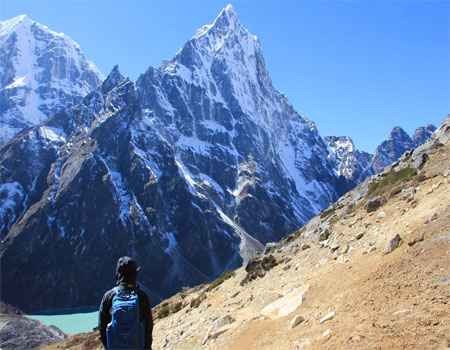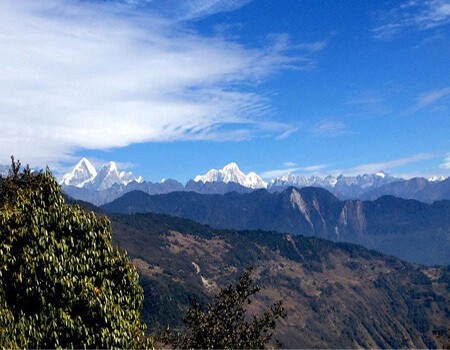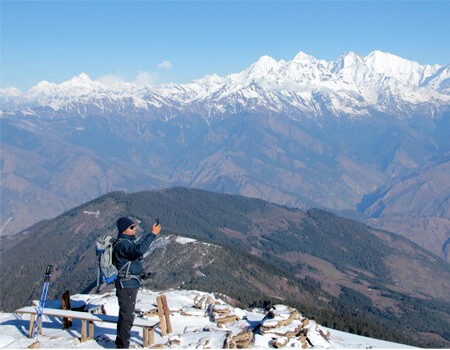Best time for Langtang Gosaikunda
The best time to trek Langtang Gosaikunda depends on your purpose. The best tourist seasons are springtime ( March to May) and autumn ( September to early December). The weather is generally stable, and this time offers clear views of the mountains and the best natural beauty.
This trek is possible throughout the year, but during the off-seasons—winter and summer—the trails are more challenging than in spring and autumn. You will have to prepare for unstable weather conditions, and therefore, your trek might not go according to your Langtang Gosaikunda Itinerary. The slippery road during the summer and the cold temperatures during the winter make it difficult.
Here is a short description of the two favorable timings for Trekking:
Spring Time
Spring is regarded as a perfect time for pictures for the Langtang Gosaikunda. It offers the best natural beauty: lush forests, unique flora, and fauna. It is also a time for the rhododendron to bloom, and the environment will be very bright. During your trek, you might also spot Danphe(Lophophorus) and Red Pandas. The temperature is also very favorable, and the weather is not very notorious, and your Langtang Gosaikunda Itinerary will most likely be the same. The tea houses will be well prepared for the incoming tourists during the season.
Autumn time
Autumn is famous for people who usually aim to go to Gosaikunda for pilgrims. The full moon of August is a holy time for Hindus and Buddhists, which makes the whole environment of the place very lively. The weather is also warm, and the trails are dry and comparatively more accessible. This time is also famous for its clear mountains and night sky views.
Langtang Gosaikunda Food and Accommodation

Langtang village
The accommodation you will get during your trek ranges from basic to standard. The services change with people's density and altitude. You will only get basic accommodation as you proceed to a higher altitude. There are no hotels or other luxurious places at any place during your trek, and the best accommodation you will get will feel very basic as it is a very rural place.
The lower altitude places have reasonable accommodation compared to the higher altitude places. You will get good twin-bedded rooms, queen bedrooms, and an attached bathroom. There is usually a facility with very slow wifi and a moderate variety of food. Not all rooms have all the amenities, and you will have to pay more for rooms with more facilities. The toilets at the lower altitudes are Western-style, but as you ascend, there is a higher probability of finding a squat-type toilet. Carrying toilet paper alone is always a good idea, as most places do not offer toilet paper.
Almost all the tea houses have a hot water facility for showering. You might have to pay extra, but it costs around $2 per person, which is reasonable given the effort required to heat it. The cold water is always free.
The rooms will decrease their facilities, and so will the variety of food choices as you ascend to higher altitudes. The only available good food will be Nepali Daal Bhaat and other local foods. A few places might offer Western food, but you must pay more. It would be best to eat Daal Bhaat as it is very filling and has a balanced diet.
If you go during the peak seasons, you must book ahead according to your Langtang Gosainkunda Itinerary, or they might run out of Accommodations.
Langtang Gosaikunda Difficulty

Lauribina La pass
The most important question before the trek is,' How difficult is it?' Answering this question, we would say that this trek is moderately complex and requires about two weeks to complete. It does not demand any previous practice but requires good stamina and strong mental power. The difficulty depends on your route, but the standard route is moderate, with a few steep and downhill sections.
The Langtang Gosaikunda is a perfect trek for beginners with no experience. It is not very demanding, and only a few places have problematic slopes and paths. Your Itinerary includes easy walks with enticing views.
The most common health difficulty you might witness is altitude sickness. We advise taking the medication before ascending to ease your trekking experience, as the symptoms might be very harsh.
Carry proper gear, comfortable shoes, and medications to reduce the difficulty of your trek. The time you choose to trek also affects the difficulty of your trek. If you want to avoid climatic problems, select the pre-monsoon or post-monsoon season.
Langtang Gosaikunda Itinerary
The Itinerary for Langtang-Gosainkunda depends on your preferred route and can be customized to meet your demands. It usually takes about two weeks to complete. You must walk daily and be mentally prepared, as no other option exists. The itinerary day-to-day itinerary is listed below.
Day 1 - Arrival at Tribhuvan International Airport
Flying to Kathmandu will be the first step toward your exciting Langtang Gosaikunda. You will be our guest as soon as you and then. One of our representatives will pick you up from the Tribhuvan International Airport and transfer you to your hotel. The distance you have to travel depends on where you are staying.
For this first day, there are no events scheduled. You will have the day to relax, roam around the valley or prepare for your most awaited trek. You can meet us for a short briefing about your trek and meet the people who will accompany you.
Day 2 - Kathmandu Valley Sightseeing
The next day, we are scheduled to take you around beautiful Kathmandu city and cover the essential destinations in the valley. You can customize your day according to your wishes, but you must inform us beforehand.
For a usual day around the valley, we take you to all the UNESCO World Heritage Sites with a good guide and then leave you at the Thames for a few hours. You can buy or rent knock or original gear, souvenirs, and other local products. There are a lot of restaurants in this area offering a wide range of delicacies. You can find almost anything you need here.
Day 3 - Drive from Kathmandu to Syabrubensi
On the third day of your Langtang Gosaikunda, we will drive from Kathmandu to Syabrubensi. We will drive northwest for about 8 hours until we reach Syabrubenshi. During the drive, you will witness clear views of the mountains at various points.
You will spend the night in a teahouse here and relax before tomorrow's trek. Tomorrow will reach an altitude of 1550 m.
Day 4 - Trek from Syabru Bensi to Lama Hotel
On the fourth day of your trip, you will finally start the walking part. You will leave Syabrubensi soon after breakfast for a long day of walking. We will cross the Bhotekoshi River, visit the Gompa of Guru, and ascend to a subtropical forest. You will get to witness the wilderness of Nepal and a lot of rare flora and fauna if you are lucky. From there, you will ascend to Rinche and reach Lama Hotel to spend the night there.
You will have to walk for about 7 to 8 hours to reach Lama Hotel at an altitude of 2450 m.
Day 5—Trek from Lama Hotel to Langtang Village. Today's will be more uphill than yesterday's, spent about 4 to 5 hours through the forests above Langtang Khola. On your trekking route to Langtang Village, you will also catch glimpses of Langtang Peak and Lurung Peak. You will pass through meadows, U-shaped glacials, helipads, yak pastures, Tamang villages, and prayer wheels to Langtang Village. This place is at 3450m and has a beautiful Tibetan settlement.
Day 6 - Trek from Langtang Village to Kyajin Gompa
The goal for the sixth day is to reach an altitude of 3870 m. Although the walking time is short, the hike is challenging because of the high altitude. You will feel tired and breathless more easily. Gradually ascending is also suitable for your adaptation altitude problem. Therefore, we will walk for about three hours through Mundu Village, streams, and Kyajin Gompa.
Day 7 - Explore Kyajin Gompa
Today is set aside for you to acclimate to the altitude and rest. You will explore the Kyanjin Gompa area and reach the highest point of our trek today. The area includes a famous monastery and a must-visit cheese factory.
As we explore this place, we will also walk up to the glaciers of Langtang Valley at various panoramic viewpoints. We will spend the night in Kyanjin Gompa.
Day 8 - Trek from Kyajin Gompa to Lama Hotel
You will leave early after breakfast and return to Lama Hotel to spend the night here. You will be heading towards Gosaikunda Lake. You will have to walk for about 6 hours while observing majestic mountains, green forests, streams, and other breathtaking natural beauties. You will view fantastic views of the snow-capped beauties on your downhill trails and cover up for everything you missed while going up.
Day 9 - Trek from Lama Hotel to Thulo Syabru Bensi
On the ninth day of your Langtaitineraryunda trek Itinerary, you aim to reach Thulo Syabrubensi after walking for about six hours. The trail begins alongside a river and takes you through pine forests. You might encounter red pandas, boars, and other flora and fauna. Once you reach Thulo Syabru, you can witness beautiful Tamang culture and tradition, with breathtaking mountain views. The ethnic practices are very well preserved in this village.
Day 10 - Trek from Thulo Syabru Bensi to Lauribinayak
After about an hour from Thuhour's bribensi, you will reach Lauribinaya, where you will spend the night. This place is at an altitude of 3910m. Today, you will need a few slippers and steep trail, but our well-trained guides will help you.
Do not miss the sunset from Lauribinayak and explore the monastery there.
Day 11 - Trek from Lauribinayak to Gosaikunda
We will leave Lauribinayak and follow a trail that ascends above the treeline. After walking for some time, you will witness about a dozen lakes in the Gosaikunda basin. Some of the famous lakes you will get to visit are Saraswatikunda, Bhairabkunda, and Gosaikunda. These lakes are essential in Hindu culture, as Lord Shiva created these lakes to quench his thirst.
You will reach an altitude of 4450m when you reach Gosaikunda Lake.
Day 12 - Trek from Gosaikunda to Lauri Bina pass and Ghopte
The twelfth day of the Langtang Gosaikunda Itinerary is challenging, according to trekkers. We will have to walk for about 7 hours at high altitudes. The destination we have to reach to spend the night is Ghopte. To get here, you will trail through a few other lakes, and Lauri Bina passes at 4609 meters. The trail then descends towards the pine forests of Ghost.
Day 13 - Trek from Ghost to Kutumsang
Today, you will have to walk for about 6 hours to Kutumusang. On average, it takes about 6 hours to reach Kutumusng. Although the trail is downhill, it isn't because it isn't irregular. 14 - Trek from Kutumsang to Chisapani.
The trail today is easy. You will have to walk for about 6 hours through greenery and vegetation. The trail is relatively uniform and at a lower altitude, making it easy.
Chisapani offers more suitable accommodation and many facilities than the tea houses above. Make sure to watch the sunrise from Chisapani.
Day 15 - Trek from Chisapani to Sundarijal and drive back to Kathmandu
After having breakfast in Chisapani, you will begin your hike toward Shivapuri National Park. The trail passes through forests, and there is a chance to spot various animals and birds. After about four hours of walking, you will reach Sundarijal and drive for about 2 hours to reach Kathmandu Valley.
We offer a complimentary farewell dinner with our team to celebrate your success in completing the Langtang Gosaikunda trek.
Day 16 - Drive to Tribhuvan International Airport for departure
Congratulations on completing the Langtang Gosaikunda. You can depart with a lifetime experience and many stories to your home. We will drive you from your hotel to the airport.
Related trips you may like:















